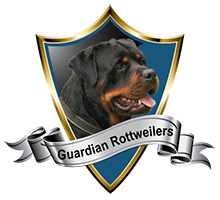First a brief explanation of how we dock tails. A purpose made small rubber band is stretched wide open with a special tool and then released onto the base of the tail. The tight band constricts blood flow, and the tail section on the other side of it “dies”. It’s common to hear about leaving the band until the tail falls off. We don’t like rotting tails attached to puppies, so we snip them off a day or two after banding once the tails go limp. We wait until the tails are thick enough to hold the band, normally around 5th day after birth, but also depending on the size of the puppies. Puppies’ reaction to the banding is minimal. We do the banding right after a feeding when the pups are most relaxed and are in a “food coma”. At most they will squeak one time after the band is released onto the tail, then may whine for 10 minutes. Just recently we had our quietest litter yet, the puppies never made a sound after the banding. There is no feeling in the tail after it dies, the snipping off produces one squeak and there is no blood.
By contrast having tails docked at the vet’s is traumatic. There’s cutting, bleeding, stitching, and the puppy experiences pain throughout the process which is about 3-5 minutes. It’s completely unnecessary to do it that way with young puppies. The vets do it because they must complete the procedure in one visit, and so they can charge for it, it would be hard to justify paying for a rubber band. Additionally doing it our way (banding) produces perfect tails aesthetically, there is hardly any built up scar tissue, in other words the end of the tail stump is smooth and fully covered with hair. And the puppies don’t need to be taken out of the home environment and transported to a place where they may get exposed to disease. Docking tails is easy for us and the pups when done right.
Why dock rottweiler tails? Most often this question comes from people who have a visceral negative emotional response to docking. They think the animal is traumatized by the procedure, and in some way cruelly treated at maturity having had a necessary body part taken away. All we have to say to those people is: Get over it! Many dog breed standards call for a docked tail for various practical reasons. Most sheep get their tails docked. Most pigs that end up in your ham and cheese sandwich were castrated with the same method. As are most male horses. Tail docking is never going away.
The iconic look of the rottweiler is without a tail, that’s how it’s been for a century (that we have photographic evidence of). Only in recent years has the German standard for the rottweiler changed with regards to the tail. We believe this to be a response to “woke” ideas proliferating in dog ownership. Same reason why common sense effective dog training methods are frowned upon, and the astronomical rise in numbers of undisciplined uncontrollable dogs resulting in incidents of aggression. In the United States for the vast majority of people the image of a Rottweiler is one with a docked tail. If we don’t dock the tails most of our potential puppy owners would be turned away.
As for practical reasons. If you’re not aware of it yet we believe the Rottweiler is meant to be a protection dog, and our breeding program aims to produce working protection dogs. To perform as a protection dog certain physical and mental attributes are required. One of these attributes is an aggressive reaction to threat and pain. Consider having your Rottweiler in public where at times it may be sitting or lying down while people are milling about. If someone steps on the dog’s tail the dog may strike. The tail can be used against the dog to control it in a fight. Also preventing a situation where a child grabs the tail is a factor.
In general having a big active dog with a wagging hairy tail around the house is a nuisance. Tail carriage is something to consider, not having a standard for the physical appearance of a tail for so long rottweiler tails tend to be inconsistent. A curl in the tail of an otherwise good dog makes it look silly and the dog loses its serious attitude.
We can’t think of any negatives to tail docking. It’s important to be able to read your dog by its tail, we don’t have a problem with that as the stub is quite expressive. And of course the ears are just as important to let you know what your dog is thinking. If you do an internet search on reasons for tail docking, and focus on objective explanations rather than those pushing an agenda, you’ll find the most practical of those relating to hunting dogs. While individuals of the Rottweiler breed are capable of performing in this arena, we don’t hunt our dogs. As such in this article the honestly stated reasons for docking are our own and work for us.
